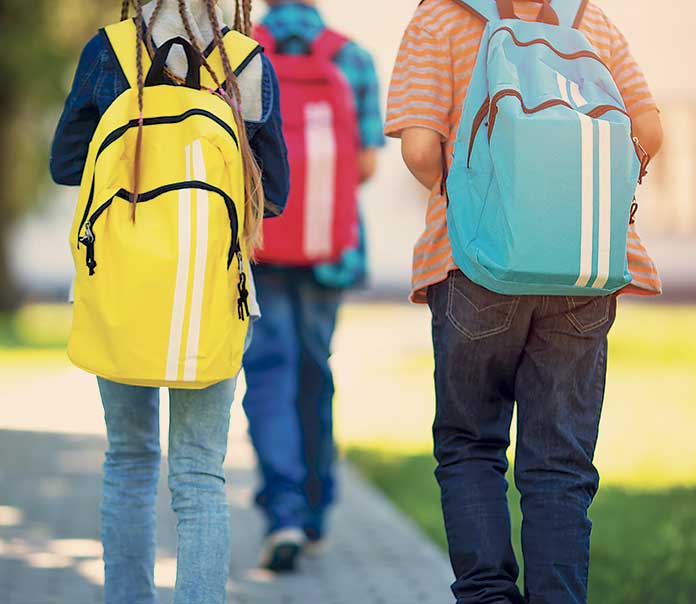Carrying around excess baggage can be hazardous to your health — and we’re not talking about your weight or emotions. Whether you tote a schoolbag, designer purse, gym duffle or briefcase, filling your bag to the brim can wreak havoc on your joints and muscles.
Ruth Gronde, an ergonomic therapist at Piedmont, says carrying a heavy bag incorrectly or for a long period of time can lead to back, neck and shoulder pain and even serious injury.
Don’t Be a Fashion Victim
“Big bags are pretty fashionable now and unfortunately, we tend to fill up the space we have,” she explains. “Fashion doesn’t necessarily make us carry bags that are proportionate to our body size or purpose.”
If you plan to carry a bag for a long period of time – say you’re running errands for several hours on a weekend afternoon – switch to a smaller cross-body purse, fanny pack or even a backpack, says Gronde.
If you do choose to heft around a large shoulder bag, “minimize what you’re putting in it – don’t be tempted to fill it up. Only take the necessities.” She also recommends alternating the shoulder on which your carry your purse throughout the day.
Backpack Safety
Backpack safety definitely isn’t too cool for school. “There’s been a big push for education around proper backpack-wearing,” says Gronde. “The most common guideline is that you or your child shouldn’t carry a backpack that is more than 10 to 15 percent of your body weight.”
Her schoolbag safety advice:
• Choose a backpack that can be worn closer to the middle of the back and not down by the waist.
• Wear it as close to the body as possible so there isn’t a gap between your back and the bag.
• Look for a version that has a strap that can be connected across the body for additional stability.
• Choose a backpack that has the thickest straps possible to help distribute weight more evenly.
• Encourage your child to wear both straps. While it may be “cool” to carry a bag with one strap, it puts him or her at risk for injury.
• Pack the bag so the heaviest items (such as textbooks) are closest to the back.
• Look for a bag that has several pouches or compartments, which will help distribute weight more evenly.
• Consider a rolling bag if you must carry heavy items, such as multiple books or a laptop.
• Utilize e-books when possible so your child doesn’t have to carry home heavy textbooks each night.
• Clear out binders and folders. Toss extra papers to reduce backpack weight.
Travel Safely
Hefting a weighty carry-on bag into the overhead bin on an airplane can put you at risk for injury. In fact, the US Consumer Product Safety Commission says in 2009, more than 54,000 people were treated for luggage-related injuries. “Minimize the weight of your luggage if you aren’t checking your bags,” says Gronde. “You have to be able to lift the bag into the overhead bin by yourself.”
If you are traveling with multiple bags, “condense and combine loads. Have fewer small bags and loads. For example, carry your purse in your computer bag or carry-on.”
Additional luggage safety tips:
• Always bend at the knees when lifting luggage; never bend from the waist.
• If you carry a duffle bag or one with a single strap, be sure to switch which shoulder you carry it on often.
• When placing your carry-on luggage in the overhead bin, first lift it to the top of the seat in front of you, and then place it in the bin wheels-first.
• Remove the bag handle-first and lower it to the seat in front of you to gain stability.
Prevent Injury During Daily Activities
Improperly lifting and carrying bags can lead to painful injuries of the spine, shoulders and neck, including muscle fatigue and strain, and even a torn rotator cuff, which could require surgery.
When carrying grocery bags, resist the urge to grab as many plastic bags as possible to cut down on the trips from the car to your kitchen. If you have reusable shopping bags, avoid filling them completely, as they can easily hold more groceries than a standard plastic bag. “You could strain a number of muscles between your hand and your spine,” she says. “Take more trips with lighter loads. Don’t reach far into the car with a heavy load. Put the heaviest bags in easy to reach places.” Gronde says correct posture can help prevent injury as well.
“Square your shoulders and try not to hunch forward or hold your shoulders up higher,” she explains. “Don’t twist your body when you are lifting a bag – this is a risk factor for back injury because it can cause damage to spinal joints and disks.” If you do get injured from carrying or lifting a too-heavy bag, Gronde recommends basic first aid measures.
With your doctor’s permission, “apply heat and ice, and use over-the-counter anti-inflammatory medication,” she says. “Avoid the offending problem – don’t keep carrying a heavy purse on your right shoulder if you are having pain. Seek medical attention if the pain isn’t getting better after a few days or if it is severe.”
For more advice on Living Better, visit Piedmont.org.
From LIVING Better
Piedmont.org













Leave a Comment
You must be logged in to post a comment.